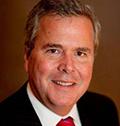
When I entered office in 1999, the greatest environmental challenge facing Florida was the rapidly deteriorating state of America’s Everglades. For years, the sensitive subtropical ecological system had suffered the side effects of a massive manmade drainage system and rapid regional development that harmed the water supply, diverted water from the natural habitat and threatened the many species that call these unique wetlands home.
During the next eight years, we would make the restoration of America’s Everglades one of the state’s top priorities. We convened a broad and diverse coalition of stakeholders to develop a strategy that became known as the Comprehensive Everglades Restoration Plan. In 2000, through a historic partnership, the State of Florida and the federal government each committed to a 50-50 percent share of costs to implement a series of more than 60 projects during the next two decades that would clean up and restore the Everglades.
We were dedicated to repairing and protecting one of our nation’s greatest treasures — in a fiscally responsible way that ensured we did not overcommit the state beyond taxpayers’ ability to pay for the projects, and invested wisely to yield real environmental benefits.
Unfortunately, Congress did not live up to the promise it made.
Instead of forgoing the state’s commitment to restoration, we aggressively expanded it. To accelerate our work, we developed a creative solution to fast-track the most critical projects. Our $1.5 billion Acceler8 plan prioritized for early construction the most beneficial projects across the system, including storage and treatment reservoirs for the Caloosahatchee, St. Lucie and Everglades Agricultural Area (EAA) regions.
The necessary land was acquired, the projects were designed, and the state was proud to stand with the South Florida Water Management District as we broke ground on six Acceler8 projects, including the massive 17,000 acre EAA reservoir.
By 2007, Florida was on its way to realizing a restored habitat and a more adequate, cleaner water supply for the state. We were on a steady and reliable path to restoration that enjoyed broad support from members of the business community, environmental advocates and the general public.
Unfortunately, this tremendous progress came to a halt under Gov. Charlie Crist’s failed leadership. In 2008, after hundreds of millions in taxpayer dollars had been spent constructing the critical EAA reservoir and other planned projects, Crist ended the Acceler8 plan midway, leaving these projects abandoned and unfinished. It was a massive disappointment to so many leaders and residents across Florida who were committed to restoring the Everglades and who expected the state and local partners to live up to their promises.
Rather than focus on what the Everglades needed and the projects already underway, Charlie Crist had an irresponsible plan to spend $1.75 billion on land and assets that the state could not afford. From the day the boondoggle deal was announced, Everglades restoration stalled out, stuck in litigation and political controversy.
Like many of his failed initiatives while in office, Charlie Crist’s $1.75-billion proposal to buy out the U.S. Sugar Corporation was nakedly political, lacked a thoughtful plan or vision for achieving results and contained astronomical hidden costs for taxpayers.
Fortunately, Charlie Crist did not run for re-election to the state’s highest office, and during his tenure, Gov. Rick Scott has worked to put Everglades restoration back on the right track.
Scott, together with partners in the Florida Legislature, last year passed a new $880-million restoration plan with real, enforceable goals, and a steady stream of annual funding. Through the plan, the state is once again fulfilling its responsibility to restore the quality of water flowing into the Everglades. Work is also being fast-tracked on water projects again to help the embattled Caloosahatchee and St. Lucie estuaries. And, Scott secured $90 million in state funds to support completion of a federal project that is raising the Tamiami Trail Bridge so more clean water can flow to Everglades National Park.
Scott has fulfilled his commitment to move forward with Everglades restoration and strengthen Florida’s environment. His record stands in stark contrast to Charlie Crist’s failure to make real progress on this critical environmental challenge. In an effort to grab headlines, Crist undermined Florida’s history of comprehensively and aggressively working to restore the River of Grass. We know exactly what four more years of Charlie Crist would bring — empty promises, petty political gamesmanship and initiatives Florida cannot afford.
Jeb Bush served as the governor of Florida from 1999-2007. This column originally appeared in the Miami Herald on October 26, 2014.


